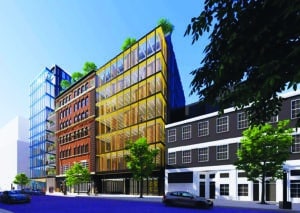
HYM Investment Group is embracing the mass timber construction technique at its 16-million-square-foot Suffolk Downs development in East Boston and Revere. Image courtesy of Leers Weinzapfel Assoc.
Wood-framed construction might historically be associated with single-family homes, but mass timber – an engineered wood product – increasingly appears to offer benefits for a wide range of commercial building types.
Residential and development experts say that can help keep costs down in a notoriously expensive building market like Boston, while helping the city achieve its latest climate and sustainability goals.
Those benefits inspired the Boston Planning & Development Agency and the Boston Society for Architecture to launch the Mass Timber Accelerator Program, which promotes the use of the emerging building type in projects across Boston and New England.
“People generally think that mass timber construction is used only in low- to mid-rise buildings, which is no longer the case,” Ellen Perko, an associate principal at architecture firm CBT, said in an email to Banker & Tradesman. “With advances in the technology used to develop [cross-laminated timber, or CLT], the product’s use is actually ideal for structures of increasingly greater height in urban and ex-urban locations.”
Projects selected for the program this year include a planned 8-story building designed by Elkus Manfredi Architects with a mix of affordable and market-rate housing at Suffolk Downs for The HYM Investment Group, developer of the 161-acre former racetrack property.
Other projects in the accelerator include a CBT-designed 7-story office building at 110 Canal St. in Boston’s Bulfinch Triangle planned by developer Quaker Lane Capital. The building, CBT’s former headquarters, is likely to get redeveloped either as a multi-tenant office project or as multifamily residential. The architecture firm is also involved with the redevelopment of South Boston’s Mary Ellen McCormack public housing project in partnership with Winn Development and the Boston Housing Authority.
“In both scenarios, we aim to leverage CLT’s advantages: The ability of the CLT floor panels to cantilever beyond exterior walls can allow for bay windows and upper balconies (rather than attaching a metal balcony to the exterior structure),” Perko said. “Thermal bridges – areas in a building with increased heat flow – therefore do not need to be addressed for these cantilevered balconies. In addition, the typical spans for the beams and CLT panels create a structural grid that complements the small footprint of the site.”
Carbon Footprint Shrinks at Timber Projects
Sustainability is a huge driver in the region’s push to pursue more mass timber projects.
Trees grow naturally, in contrast with building materials that need to be extracted from the ground. Further, mass timber is manufactured in a warehouse and can be more precisely measured to project specifications, meaning there is less on-site labor and a reduced amount of construction waste to remove.
“Unlike many other regions, the northeast U.S. and neighboring Canada have a special advantage of land-based access to regionally sourced timber,” Perko said.
Shorter shipping distances reduce transportation-generated greenhouse gases, reducing projects’ carbon footprints, she added.
The move comes as Boston leaders aim to gradually reduce greenhouse gas emissions of the city’s largest buildings and eventually achieve net zero emissions by 2050.
“It is imperative that development companies reimagine the way we build and pivot: from a carbon-intensive industry to one that is actively taking steps to remove carbon from the atmosphere,” said Doug Manz, partner and chief investment officer at HYM Investment Group.
There are financial reasons for embracing mass timber in more developments across New England as well – meaning there may soon be a day when labs aren’t the popular choice for available parcels in Greater Boston.

Other projects in the public-private Boston Mass Timber Accelerator include a CBT-designed 7-story office building at 110 Canal St. in Boston’s Bulfinch Triangle planned by developer Quaker Lane Capital. Image courtesy of CBT
Potential to Boost Affordable Housing Production
Affordable housing often doesn’t financially pencil out when you factor in the high cost of acquiring land, buying materials and finding construction labor. The lower costs and efficiencies associated with mass timber means affordable housing can be a viable option for a parcel of land most conducive for a 6- to 12-story building, according to Tom Chung, a principal at Leers Weinzapfel Assoc. and whose firm worked on Eliot Church – a 4-story affordable housing project in Roxbury that was also included in the Boston Mass Timber Accelerator.
But aesthetics also play a part.
“It’s wood and has biophilic qualities – warmth to touch, the visual texture and fresh smell – that makes it more welcoming and a more pleasant space to live and work as opposed to exposed steel or concrete or white painted drywall,” Chung said.
Owners have seen faster lease-up times as well in exposed wood buildings that improve a project’s financial bottom line, Perko added.
Perhaps the only thorn in mass timber’s side is the notion of safety. Those interviewed for this story emphasized the safety benefits of mass timber and noted the building type behaves very differently than light-frame wood, which is prevalent in low-rise construction. Apartment complexes in Dorchester and Waltham built with light-frame wood caught fire in spectacular fashion during construction in recent years, in both cases causing total losses.
When mass timber is exposed to fire, the char forms a protective layer to keep the rest of the wood’s structural integrity, Chung said. Additionally, he pointed to recent changes to building codes enabling up to 18 stories of mass timber construction without requiring a variance, signifying regulators’ confidence in its safety as a building material.
“This science is advancing rapidly as the demand for sustainable construction methods grows, and we’re finding marked increases in the safety of CLT buildings all the time,” Perko added. “To this end, the building code is currently under review for imminent changes in the approved application of CLT – a reflection of its increased safety thanks to research and scientific progress.”





